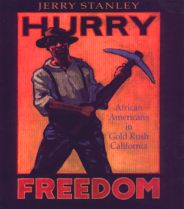|

Hurry Freedom
Stanley, Jerry. 2000. Hurry Freedom:
African Americans in gold rush California. New York: Crown
Publishers. ISBN: 0517800942.
In this 2001 Orbis Pictus winner, Jerry Stanley tells the story of what
life was like for African Americans during the Gold Rush in California
in the late 1840's to 1850's. They had come to California via
different routes - some as slaves, some over the plains of the
Southwest, and some by steamer. Some found riches and were able
to buy freedom for other family members, some never struck gold, and
some ended up enslaved yet again. But all found California to be
an intolerant climate for the African-American man.
In the introduction, Stanley explains, "Few African American
forty-niners kept records of their experiences in California. But
Mifflin Wistar Gibbs did." (Stanley, p.3) Gibbs's
rags-to-riches
story is the unifying thread throughout the text, but also included are
many accounts of the lives of other African Americans in California at
this time. Glaser praised Stanley's focus on Gibbs in her review
for School Library Journal,
which said, "This narrative choice lends the book a biographical feel
rendering it highly readable." Gibbs was a successful entrepreneur but
also an
activist. Through telling the story of his crusade for one simple
measure of equality - non-whites' right to testify in court - Stanley
is able to bring in the history of the period and also tell the stories
of many others. Carter commented on Stanley's choice to include stories
of others in her review for Horn
Book Magazine by stating, "Unfortunately, the account loses its
strong focus when Stanley's narrative expands to include those African
Americans mining for gold or working in the fields or struggling for
basic freedoms in Sacramento. Here, statistics (such as the
numbers of African Americans living in various portions of the state or
attending various conventions) substitute for the telling details of
personal lives so richly employed in the sections on Gibbs and San
Francisco." Although the stories of the struggles of other minorities
are not as strong in focus, they do serve to give the reader a thorough
look at the widespread prejudice of the day.
Stanley's writing style is conversational, and he
sometimes speaks directly to the reader, such as "Imagine him sitting
on a bench in a park reading about the events as they occured."
(Stanley, p.72) Stanley's dry wit also comes through at times
when he
seems to convey his disdain for the stupidity of the prejudice endured
by Mifflin, such as this paragraph that closes chapter four and offers
a description of the environment Gibbs and his partner faced when they
opened their business: "Two years before, a California newspaper
had screamed, 'Free Negroes are idle and thriftless and we do not want
them in the state!' A year after that, William Gwin, United
States senator from California, said, 'God created Negroes for slavery
to serve the white race. They are not suited for freedom and they
are most happy as slaves.' Mifflin Gibbs and Peter Lester ignored
both statements and checked the cash register for a supply of change."
(Stanley, p.35)
The book is illustrated with black and white photographs and
drawings. Many of the people profiled in the book, such as
Mifflin Gibbs and Peter Lester, are shown in portraits. The text
is organized into nine chapters and also includes an introduction and
an epiloge. Each chapter is numbered and is also titled with an
appropriate quote from that chapter. The text is printed in a
medium serif font, and each page includes significant white space on
the outside edges. A bibliographic note is written in paragraph
form. This note includes sources used, and they are organized by
subject. This two page note seems to open up Stanley's research
notebook, and it allows the reader to see the depth of study put into
this text. There is also an extensive index and a section that
lists picture credits.
|

